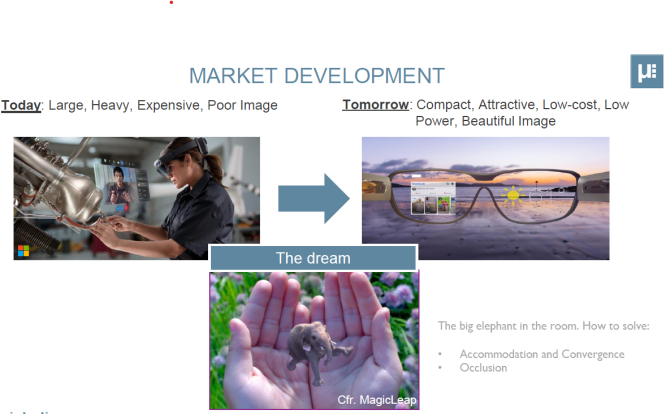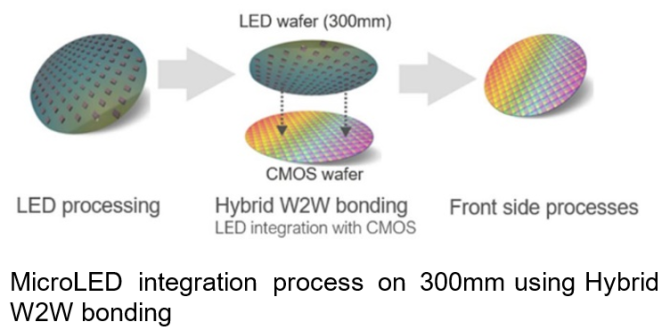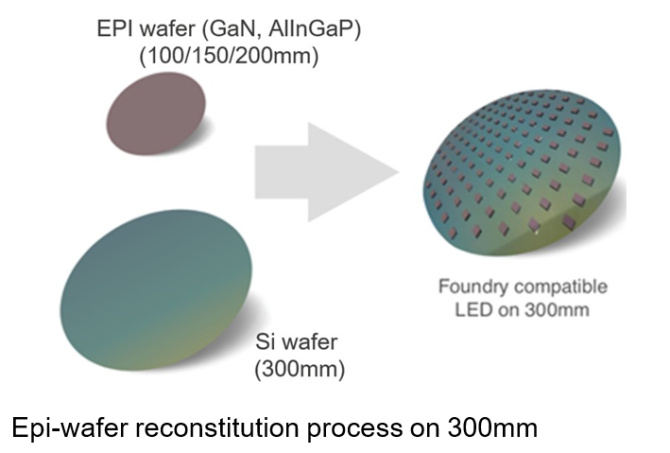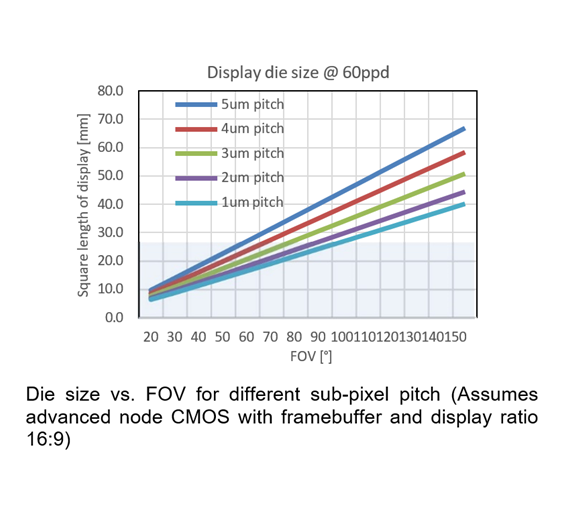
AR display systems are the new reality
EP&T Magazine
Automation / Robotics Electronics Optoelectronics displays Editor Pick Microdisplays opto optoelectronics ARMICLEDI seeks to satisfy technical challenges in the emerging technology
New tech start-up MICLEDI Microdisplays (from IMEC in Belgium) was founded in response to the growing interest in display systems for augmented reality (AR) eyeglasses. With the objective to satisfy technical challenges in the emerging technology, MICLEDI remains focused on the microdisplay module, one of the mission-critical components of AR.
As has occurred with OLEDs for mobile computing and television displays, merging the light source and pixel together into a simplified display subsystem results in a solution for AR glasses that can address the form-factor, design and wearability problems of currently available systems.

Source: MICLEDI Microdisplays
One of the most significant values of µLED solutions is brightness. Brightness of other methods (OLED, LCOS, DLP, others) is too low for transparent lens displays for outdoor use in natural sunlight. µLED displays can produce between 1 million nits and 10 million nits which can create a vibrant and clearly visible full color image on clear lenses in bright sunlight.
Consumers don’t want to look like Darth Vader wearing the digital display “headset” of the future. They demand stylish, attractive and comfortable eyeglasses that can be worn all day, inside and outside. They desire AR glasses that can serve as a combined digital display for the myriad mobile consumer computing, communication, and image capture devices including cell phones, watches, tablets, cameras, drones, and other portable devices. Augmented reality glasses are gradually moving from the bulky and expensive products used in industrial, enterprise and military markets to lightweight, low-power, and price sensitive consumer products.
For this evolution to take place, visual performance is key. Significant progress has been made by industry leaders on the front-end and back-end of the AR glasses system topology. The front-end includes the power/wireless/video-pipeline part of the AR glasses ecosystem. The back-end includes the optical part of the system which receives the light from the display module and projects the images from the emitter onto the retina by way of optical combiner/waveguide technology. The piece in the middle is where remaining challenges exist.
Technology of choice
Many companies are betting on microLED displays to solve this middle challenge. Impressive microLED prototypes have been shown in recent years. Some target specifications as well as volume manufacturing still pose challenges. MICLEDI has introduced a µLED process-flow with backplane integration that is realized in a 300mm CMOS line using standard volume manufacturing equipment. Proof-of-concept validation is achieved with a similar integration scheme as is done for 3D-stacked backside illuminated imager in volume production today.

Source: MICLEDI Microdisplays
The main differentiation of µLED display modules, when compared to other microdisplay technologies, are resolution and brightness. Other parameters, such as power budget, image quality, yield and cost will also influence the integration methodology.
Brightness targets for µLED display modules for AR glasses based on waveguides, derive from the fact that only 3% or less of photons generated by the display module will reach the eye either being attenuated by projection optics and combiners/waveguides, or wasted to accommodate human factors such as interocular distance differences. This means for outdoor usage in transparent, or clear-lens glasses, 1-10 million nits “white light” needs to be generated with a similar power budget to a mobile phone display (<1W). The brightness limits of non- µLED light sources are insufficient for true clear-lens consumer AR.
Manufacturability
One of the most significant barriers to adopting µLED-based microdisplays has been the manufacturability of the display modules. 300mm wafer manufacturing is an enabling part of the solution. This graph illustrates the display size for different pixel pitches including driver and interface circuitry that extends beyond the pixelated active area applying basic assumptions about the backplane ASIC performance in an advanced node (<45nm).
For just a 5µm pitch FHD display, the practical limits of reticles size of the exposure tool in an advanced foundry are being approached. This will strongly impact manufacturability and yield. To strike an appropriate compromise, MICLEDI has designed and optimized a µLED panel for each colour: red, green, and blue.

Source: MICLEDI Microdisplays
Another challenge is the integration of the µLED display module to the ASIC backplane. There are many different methods for accomplishing this that are in current use for different types of displays – OLED, LCOS, others. This figure illustrates the different approaches. It is MICLEDI’s contention that integration of the front and back planes can best be achieved in a self-contained 300mm manufacturing flow using a proven and proprietary hybrid wafer-to-wafer bonding method with devices available for demonstration today.
Since LED starting material is not available in 300mm wafers, and if it were there would be major challenges with wafer stress, bow, and planarity for wafer-to-wafer bonding with the backplane ASIC, it is necessary to reconstitute best-in-class epi material onto a 300mm silicon carrier wafer, which can then proceed through the manufacturing tools available in world-class CMOS fabs. This figure illustrates the resizing of GaN epi wafers by dicing and repopulating the epi chiplets of a 100 to 200mm wafer onto a 300mm Si wafer. Also shown is the subsequently manufactured µLED wafer which is ready to be bonded to a CMOS ASIC backplane in a proprietary process. The spacing of the epi chiplets is a function of the spacing needed to align with the chosen backplane design and wafer map.
Business model
In the display module arena, integrated front and back planes can be designed, made, and sold as an integrated module by the µLED maker. Another option, for larger OEMs with unique market requirements, is for the OEM to design the backplane ASIC and port the design into a compatible fab for integration with the front plane µLED. A third option for especially large and capable OEMs might be to license to them the unique elements of µLED manufacturing and enable them to produce the display modules themselves.

Source: MICLEDI Microdisplays
At the present time, with AR ‘headsets’ for military, industrial, and enterprise solutions priced between USD$1,000 and $5,000, and even higher, market adoption is limited to niche applications. As the cost, size, resolution and power of display modules based on µLEDs drives into the realm to meet consumer specs, demand will skyrocket into volumes rivaling cell phones and tablets.
The business model for each of the three elements in the system topology for AR glasses is similar. At this stage of market development, specialists in front-end, back-end, and the middle supply highly specialized and optimized components which are bought by OEMs who integrate them into their unique AR glasses. Specialty suppliers design, make, and sell ICs to enable the front-end – wireless/GPU/power. Other specialty suppliers design, make, and sell optical engines and waveguides to serve the back-end. A third group of specialty suppliers, like MICLEDI, design, make and sell display modules. There are examples of certain OEMs trying to acquire specialty companies in the front, back and middle to become fully vertically integrated. The prevailing market dynamic is still disaggregated suppliers offering best-in-class solutions to front, back and middle parts of AR glasses topologies.
As the market continues to evolve, and as high-volume, low-cost methods mature, it is likely that all three business models described above will exist, adapted to the appropriate market conditions and commercial entities’ needs.
————
This article was written and submitted by MICLEDI Microdisplays, a fabless developer of microLED displays for the Augmented Reality (AR) market. The firm’s technology is based on a combination of III/V materials processing, 3D integration and 300mm Si based processing combined with a proprietary ASIC to provide a self-contained, compact monolithic AR display with high image quality and power efficiency.
